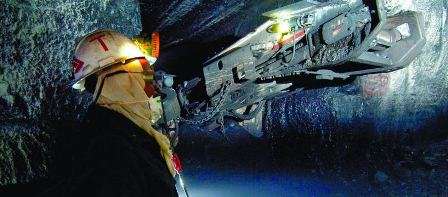Adopting new mining technology: Finding a balance between leading and bleeding

The mine of the future is coming. It will be digital, more constrained, and it will require a greater investment in leading edge technology.
"The good times are gone," said Barloworld Equipment Information Bureau Officer, JP Briggs, who outlined how mines of the future would have to drill deeper, under increased safety and environmental regulations.
So how will the mine of the present become the mine of the future? Change management and associated problems were the focus of intense discussion at this week's Mining Into The Future conference sponsored by Barloworld.
Head of the Wits School of Mining Engineering, Prof. Fred Cawood, gave a presentation introducing aspects of the mine of the future as envisaged by the Wits Centre for Mechanised Mining Systems.
Essential functions like safety, optimisation, guidance, tracking and reporting will increasingly be automated by sophisticated systems providing real-time information.
Connected worksites will mean improved communication between equipment, operators and managers. For example, there might be monitors inside mines identifying individual mine workers and raising an alarm if someone has entered an area where they're not authorised to be.miner
"A connected worksite is key. If you know more, you can do more, you achieve more," said Briggs.
The School of Mining Engineering is developing an underground, airtight test tunnel 67m long under the Chamber of Mines building on East Campus to assess the suitability of WiFi, WPAN, UWB and WiMAX to carry a mass of information many more times the amount currently being transferred in underground mines.
Changes in mining conditions will also drive new technology. For example, South Africa is expected to run out of coal a lot faster than previously anticipated, creating an urgent need for underground coal mining in the Waterberg. In this new underground environment, spontaneous combustion will be a real and on-going hazard that can only be managed by atmospheric monitoring on an unprecedented scale.
To develop atmospheric monitoring technology, a section of the 67m of tunnel under the Wits building is being used by a group developing tools for the accurate monitoring of air velocities and quantities.
Following the presentations by Cawood and Briggs on Thursday, day two of the conference, delegates raised concerns about the mining industry's ability to absorb these new technologies.
The technologies promise to help achieve a lower cost per ton or a lower cost per hour, but are the people, the processes, and – in less developed countries – the national infrastructure, ready?
According to one delegate, mines might ask: "We've been doing things a certain way for 10 years, why should we change now?"
Briggs emphasised that the new technologies were building blocks to autonomy, which could be integrated step by step on a gradual path towards the next generation of autonomous mine, rather than imposing everything all at once.
In fact, the rate at which new technology should be manufactured and sold remains a big problem for suppliers like CAT.
Customers on one end of the spectrum prefer to buy up old machines so that their entire fleet comprises the same equipment. They say that what they lose in terms of efficiency, they make up for in terms of easier maintenance and the lower risk of a proven track record. These customers can't be sold the latest technology, because it is more advanced than their equipment.
Customers on the other end of the spectrum are more willing to adopt new equipment and technology, but no one wants to be on the bleeding edge. As one delegate pointed out: "The problem in mining is we cannot afford teething problems while they sort out new products."
Provided by Wits University














